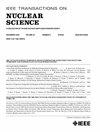Implementations of Streaming DAQ on Actual Detector Systems
IF 1.9
3区 工程技术
Q3 ENGINEERING, ELECTRICAL & ELECTRONIC
引用次数: 0
Abstract
Detector systems in modern nuclear and particle physics experiments must handle numerous channels and high data throughput. Furthermore, the requirements for trigger systems have become increasingly complex, necessitating effective decision-making processes. Streaming readouts and software-based triggering on distributed computers present a natural solution to these challenges, owing to recent technological advances. Therefore, we developed a widely usable streaming data acquisition (DAQ) system based on FairMQ and the Redis key-value database. To address this challenge, we have developed a streaming DAQ system that handles continuous data flow and complex triggering in the software. The DAQ system is relatively simple and can be deployed and operated by a small team. It operates through the cooperation of multiple elementary functional processes, with connections automatically established based on port names, service names, and connection information stored in a database. We applied this DAQ system to actual detector systems, including the Research Center for Nuclear Physics (RCNP) Grand Raiden spectrometer and the Japan Proton Accelerator Research Complex (J-PARC) E50 detector system beam test, utilizing streaming readout and online software triggering. The two detector systems, consisting of plastic scintillation counters and drift chambers, were read out by a field-programmable gate array (FPGA)-based streaming readout time-to-digital converter (TDC) and distributed synchronized clock, where the charge information was obtained from the time-over-threshold (TOT). The streaming DAQ system performed effectively, including the software trigger, on 24-core server computers. The software component of the DAQ system was also applied to a triggered DAQ system for a cylindrical drift chamber (CDC) for the J-PARC COMET experiment, where it demonstrated sufficient performance. We further demonstrated the streaming-capable DAQ system and its practical application, with a focus primarily on the software aspect.求助全文
约1分钟内获得全文
求助全文
来源期刊

IEEE Transactions on Nuclear Science
工程技术-工程:电子与电气
CiteScore
3.70
自引率
27.80%
发文量
314
审稿时长
6.2 months
期刊介绍:
The IEEE Transactions on Nuclear Science is a publication of the IEEE Nuclear and Plasma Sciences Society. It is viewed as the primary source of technical information in many of the areas it covers. As judged by JCR impact factor, TNS consistently ranks in the top five journals in the category of Nuclear Science & Technology. It has one of the higher immediacy indices, indicating that the information it publishes is viewed as timely, and has a relatively long citation half-life, indicating that the published information also is viewed as valuable for a number of years.
The IEEE Transactions on Nuclear Science is published bimonthly. Its scope includes all aspects of the theory and application of nuclear science and engineering. It focuses on instrumentation for the detection and measurement of ionizing radiation; particle accelerators and their controls; nuclear medicine and its application; effects of radiation on materials, components, and systems; reactor instrumentation and controls; and measurement of radiation in space.
 求助内容:
求助内容: 应助结果提醒方式:
应助结果提醒方式:


